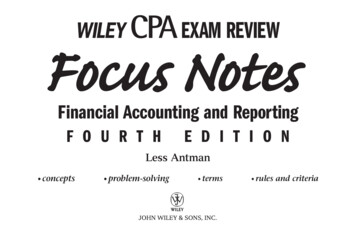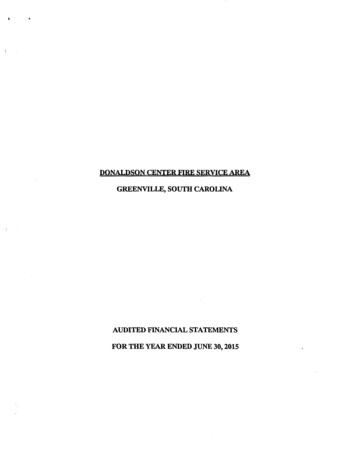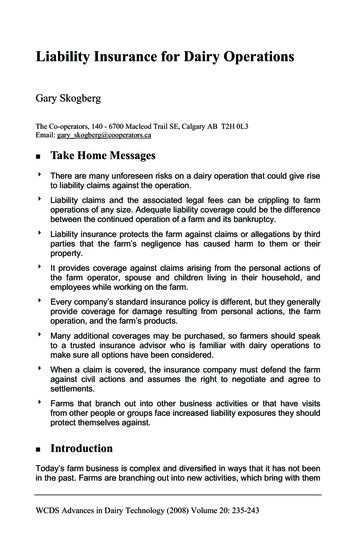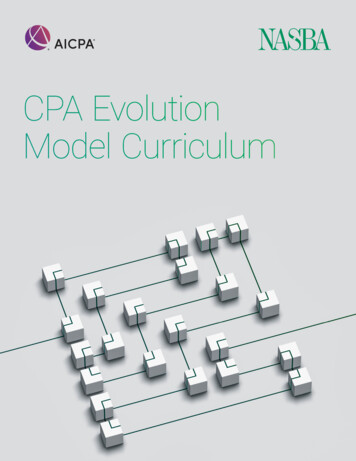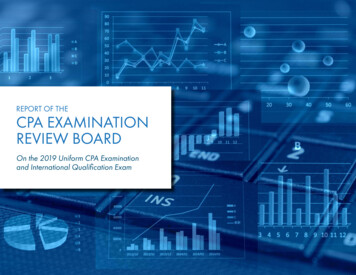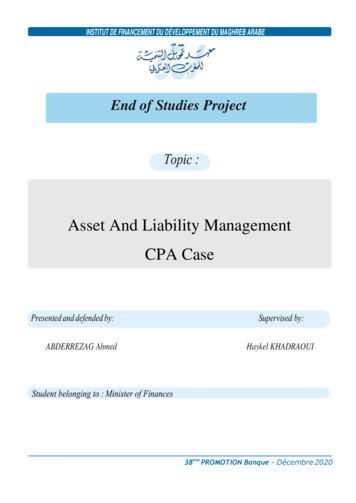
Transcription
INSTITUT DE FINANCEMENT DU DÉVELOPPEMENT DU MAGHREB ARABEEnd of Studies ProjectAsset And Liability ManagementCPA CaseABDERREZAG AhmedHaykel KHADRAOUI38ème PROMOTION Banque - Décembre 2020
INSTITUT DE FINANCEMENT DU DÉVELOPPEMENT DU MAGHREB ARABEEnd of Studies ProjectAsset And Liability ManagementCPA CaseABDERREZAG AhmedHaykel KHADRAOUI38ème PROMOTION Banque - Décembre 2020
DedicationTo My Dear Parents Who Have AlwaysSupported Me
AcknowledgementsMy first thanks are to “ALLAH” Glorified and Sublime be He, who gave me the strength,courage and determination to carry out this work.I would like to express my deepest gratitude to Haykel KHADRAOUI, who supervised thiswork and whose remarks, advices and encouragements were crucial for the accomplishment of thiswork. I express to him all my gratitude and my most sincere thanks for the trust and privilege grantedme by accepting to be my supervisor.Also, my gratitude goes to the honorable members of the jury who honored me for evaluating.I cannot forget all those who have supported and encouraged me at critical times.Finally, my thoughts go out to my family and friends to whom I have an infinite love. Maythey find in this work my deepest gratitude for their precious support.
ContentsGeneral Introduction . AChapter 01: Liquidity and Liquidity Risk . 1Section 01: Bank treasury . 3Section 02: generality on banking risks . 9Section 03: Bank liquidity and liquidity risk. . 12Chapter 02: Asset and Liability Management . 21Section 01: Asset-Liability Management. . 23Section 02: Identification and measurement of liquidity risk . 30Section 3: Hedging liquidity risk. . 43Chapter 03: Liquidity risk management by ALM at the CPA . 47Section 01: Introduction to the CPA . 50Section 02: Liquidity Measurement and Analysis by ALM Methods . 53Section 03: Analysis of results and recommendations . 77General Conclusion . 79
List of tablesTable N (2-1): Maturity Profile. 33Table N (2-2): Profile Of Outstanding Assets And Liabilities . 34Table N (2-3): Flow Dead-Ends . 37Table N (2-4): Impasses In Stock . 38Table N (2-5): The Number Method . 39Table N (2-6): Calculation Of Basic Surplus Unit: Millions . 40Table N (3-1): Maturity Profiles Of Financial Assets (Transaction/Sale). Unit: DZD . 55Table N (3-2): Maturity Profile Of Held-To-Maturity Assets . 55Table N (3-3): Maturity Profile Loans And Advances To Customers Short-Term. Unit: DZD. 56Table N (3-4): Maturity Profile Loans And Advances To Customers At MLT. Unit: DZD. 56Table N (3-5): Maturity Profile Debts Owed To Financial Institutions At Term.Unit: DZD . 59Table N (3-6): Determination Of The Stable And Volatile Portion Of Overnight Deposits . 60Table N (3-7): Maturity Profile Of Overnight Deposits. Unit: DZD . 61Table N (3-8): Maturity Profile Debts Due To Customers At Term DAT BDC Unit: DZD . 62Table N (3-9): Maturity Profile Asset-Unit: DZD . 63Table N (3-10): Maturity Profile Liabilities . 64Table N (3-11): Amortization Profile Of Assets And Liabilities. Unit: DZD . 66Table N (3-12): Assessment Of The Level Of Consolidation . 67Table N (3-13): Dead Ends In Flow.Unit: DZD. 68Table N (3-14): Dead Ends In Stock. Unit: DZD . 69Table N (3-15): The Impact Of A 1% Increase In Rates On The Bank's Profitability. Unit:DZD . 71Table N (3-17): Closing Flow Gaps. Unit: DZD . 73Table N (3-18): Investment Interest .Unit: DZD . 74Table N (3-19): Interest On The Loan .Unit: DZD . 74Table N (3-20): The New Flow And Stock Impasses Of Scenario 01 (10%) Unit: DZD . 75Table N (3-21): The New Flow And Stock Impasses Of Scenario 02 (50%) Unit: DZD . 75Table N (3-22): Impact Of A 1% Increase In The Interest Rate On The Bank's Profitability(Crisis Case) Unit: DZD . 76
List of figuresFigure N (1-1): Intermediation Of The Treasury Department . 3Figure N (1-2): Transfer Rate (TCI) Mechanism . 6Figure N (1-3): Formation Of Capital Markets . 7Figure N (1-4):: Diagrams Of The Risks To Which A Bank Is Exposed . 9Figure N (2-1): The ALM Approach . 26Figure N (2-2): Maturity Schedule Of Assets And Liabilities . 34Figure N (2-3): Securitization Mechanism. 45Figure N (3-1): Organization Chart Of The Treasury Department . 52Figure N (3-2): Analysis Of Balance Sheet Assets . 54Figure N (3-3): Analysis Of Liability Items . 58Figure N (3-4): Evolution Of Overnight Deposits At CPA. 61Figure N (3-5): The Amortization Profile Of Assets And Liabilities . 66Figure N (3-6): Dead-Ends In Flow. . 68Figure N (3-7): Dead Ends In Stock. . 70
List of FCCGAPMLTOATPELSMESTCIFrenchAsset And Liability CommiteeAsset Liability ManagementBons De CaisseLa Banque De Développement LocalComptes Courants PostauxCrédit Populaire D’AlgérieLe Dépôt A TermeDépôts A VueFond Commun Des CréancesGestion Actif-PassifMoyen Et Long TermeObligations Assimilables Du TrésorLe Plan D’épargne LogementPetites Et Moyennes EntreprisesTaux De Cession InterneEnglishAsset And Liability CommiteeAsset Liability ManagementCash VouchersThe Local Development BankPostal Current AccountsPopular Credit Of AlgeriaThe Term DepositOvernight DepositsCommon Debt FundAsset-Liability ManagementMedium And Long TermAssimilable Treasury BondsThe Housing Savings PlanSmall And Medium EnterprisesInternal Assignment Rate
List of appendicesAppendix 1: Elements For Calculating The Liquidity Numerator . 83Appendix 2: History Of Outstanding DAV Over 3 Years (January 31, 2017 - December 31,2017) Unit: DZD . 86
AbstractNowadays banking activity is under enormous pressure, which is accompanied by an increasein the level of risks, particularly financial risks (liquidity risk, interest rate risk and exchange raterisk), due to the nature of the activities carried out by banks, essentially the transformation ofresources with short maturities into expenditure with long maturities.Monetary authorities, as overseers and protectors of the banking system, have always soughtto minimize losses and optimize the risk/return trade-off by implementing risk management systems,including Asset and Liability Management (ALM).ALM is the asset-liability risk management technique that consists of obtaining a balancesheet structure that complies with the requirements of the banking system in order to maximizeprofits and avoid risky situations. It can be achieved through two lenses: the static and the dynamiclenses.Asset and Liability Management is based on three steps: identification, measurement andcoverage of risks.The identification of risk is a very important step, the purpose of which is to identify anyelement that could generate a risk on the bank's activity. Measurement is the second step, it consistsin assessing the bank's exposure to various risks, namely liquidity, interest rate and exchange raterisk, using several tools.In our work we have used ALM to study liquidity risk and for its measurement we have takenthe gap method (impasses) and liquidity indices (liquidity coefficient and transformation index) ascalculation tools.Finally, hedging can be done through several instruments and must be adequate in terms ofrisk, including the back-to-back method and derivatives.Our case study looked at the balance sheet of the Crédit Populaire d'Algérie (CPA) over theshort term (three years) to determine its liquidity position. After the results, we noticed that the bankwas in excess liquidity over the entire period studied and for its coverage we proposed to make aninvestment/borrowing. In other words, make a loan corresponding to the amount of the surplus andreuse it so as not to lose and make a profit.Throughout our brief we have tried to answer the following problematic:How can liquidity risk be managed using the ALM approach?
RésuméDe nos jours l’activité bancaire connait une énorme pression, qui s’accompagne d’unaccroissement du niveau des risques particulièrement les risques financiers (risque de liquidité,risque de taux d’intérêt et risque de change). Tout ça du a la nature des activités que pratiquent lesbanques, essentiellement la transformation des ressources aux échéances courtes en emplois avecdes échéances longues.Les autorités monétaires en tant que surveillants et protecteur du système bancaire cherchentdepuis toujours à minimiser les pertes et à optimiser le couple rentabilité/risque, en mettant en placedes systèmes de gestion des risques, notamment la gestion des risques actif-passif (Asset andLiability Management), l’ALM.L’ALM est une technique de gestion des risques actif-passif qui consiste à obtenir unestructure du bilan conforme aux exigences du système bancaire afin de maximiser les profits et évitertoute situation risquée. Elle peut être réalisée par deux optiques : l’optique statique et l’optiquedynamique.L’ALM (Asset and Liability Management) se base dans son travail sur trois étapes qui sont :l’identification, la mesure et la couverture des risques.L’indentification du risque est une étape très importante qui a pour but de repérer tout élémentpouvant générer un risque sur l’activité de la banque. La mesure est la deuxième étape, elle consisteà évaluer l’exposition de la banque face aux différents risques à savoir : le risque de liquidité, de tauxd’intérêt et de changes, en s’aidant de plusieurs outils.Dans notre travail on a utilisé l’ALM pour étudier le risque de liquidité et pour sa mesure ona pris la méthode des gaps (impasses) et les indices de liquidité (coefficient de liquidité et indice detransformation) comme outils de calcul.Enfin la couverture, elle peut se faire par plusieurs instruments et elle doit être adéquate auniveau des risques. Parmi ces instruments on trouve la méthode des adossements et les produitsdérivés.Notre cas pratique a traité le bilan du crédit populaire d’Algérie (CPA) sur le court terme(trois ans) afin de déterminer sa position de liquidité. Après résultats on a remarqué que la banqueétait en surliquidité sur toute la période étudiée et pour sa couverture on a proposé de faire unplacement/emprunt. En d’autres termes faire un emprunt correspondant au montant du surplus et leréemployer pour ne pas perdre et réaliser un profit.Tout au long de notre mémoire on a tenté de répondre à la problématique suivante :Comment peut-on gérer le risque de liquidité par l’approche ALM ?
General Introduction
General introductionGeneral introductionRisk is always present and has always been part of the financial system, and as a majorcomponent of the financial system, the bank faces a multitude of risks as a direct result of its variousactivities and services. These risks are mainly financial risks including: liquidity risk, interest raterisk and market risks.A bank is exposed to risk from the minute it decides to lend money, including the risk of notrepaying the loan and its interest. It is also in permanent risk because of its role as an intermediarythat confronts it with the threat of transformation, in other words, fluctuations in interest rates.In our research we focused primarily on liquidity risk. For a bank, liquidity risk means theinability to meet its commitments at a given time and also the risk that an asset cannot be sold at itsfair value. Liquidity risk was neglected and classified as a secondary risk until 2007, when it causedthe SUBPRIME crisis, a crisis that gradually spread to all financial markets and eventually affectedthe entire global economy, proving that if a bank is in loss or bankruptcy it can drag the entirefinancial system down the path. Whether because of its size, its degree of interdependence withfinancial institutions, or the nature of the services it provides, a bank can pose serious risks to anentire economy.After the increased level of risk and the damage to banks, the stability and soundness of bankshas become a major concern for governments and monetary authorities in any country. To limit theserisks, banking risk management systems have been put in place. These systems are designed toprotect any bank and maintain its stability and soundness in order to minimize any losses. One suchmethod is Asset Liability Management (ALM).ALM (Asset Liability Management) or Asset and Liability Management is often assimilatedto a global balance sheet management, it aims to identify risks, measure them and ultimately coverthem in order to optimize profitability while respecting regulatory constraints and the institution'sobjectives and also to keep an acceptable level of risk.In Algeria, the will to introduce modern risk management techniques is not recent. Algerianregulations have been concerned with this aspect and this was seen with the promulgation of Law90-10 of 14 April 1990 on currency and credit, text which is in the wake of the Bale I agreements.Also, with the introduction of Order 10-04 of 26 August 2010 on internal control, testimony of adesire to have this type of management at the level of banks.In spite of all the efforts made by the Algerian banking system in terms of regulations,particularly standards relating to the control and management of risks affecting liquidity andespecially the solvency of credit institutions, asset-liability management is not yet commonplace andremains little used in our banks. This is why we have set ourselves the objective of explaining theapproach to liquidity risk management and we have insisted on its importance and its usefulness. Wehave tried to answer the following problematic:How can liquidity risk be managed using the ALM approach?This issue raises a number of questions: What does cash and liquidity mean for a bank? What are its sources and its differentforms?What is asset-liability management? What are the risks of ALM and what are its tools?A
General introduction What is liquidity risk? How can it be identified, measured and how is it hedged?How does Crédit Populaire d’Algérie put this approach into practice?In order to guide our work, we have set the following assumptions: H1: ALM is a risk management technique used by the CPA to forecast its liquiditysituation. H2: changes in interest rates and the liquidity position have an impact on the bank'sprofitability.In our work we have been satisfied with the static approach, which is carried out either bythe durations method or the deadlock and liquidity indicators method, and we have found it usefulto do it by the second method in order to better show the gaps between assets and liabilities on thebalance sheet.We were able to do this work thanks to an internship at the Crédit Populaire d'Algérie (CPA)and from data corresponding to this institution.In order to refuse or confirm our hypotheses and better explain our work, we have dividedour work into three chapters, the first two are theoretical and the last one is entirely devoted to thepractical case.In the first chapter we presented the treasury and identified its objectives, functions and tools.Finally, we defined liquidity, how it is held by the banks and we presented the liquidity risk and itstypology.The second chapter examined the ALM, its objectives, mission and tools. It then explainedhow to identify and measure liquidity risk and ended with methods for hedging it.The last chapter has detailed the case study in which, after having presented our structure ofreception during the internship, we have analyzed our balance sheet and determine the risks to whichthey can be exposed, all this after a careful calculation of the profits of maturity and dead ends anda static forecast of three years, in order to come out with indications and recommendations for theCrédit Populaire d’Algérie (CPA).B
Chapter 01: Liquidity andLiquidity Risk
Chapter 01: Liquidity and Liquidity RiskIntroductionThe proper functioning of any economy and banking system depends on the health of banksand financial institutions, which in turn depends on the degree of control of risks inherent in bankingactivity.Indeed, in the course of their activities; banks incur a range of risks that need to be identifiedand managed to reduce the potential losses they may cause.In this chapter, the focus will be on the bank treasury and its role, as well as the importantrisks faced by banks, including liquidity risk.In order to do so, we have found it useful to divide this chapter into three sections: Section 1: Bank liquidity.Section 2: Generality on banking risks.Section 3: Liquidity and liquidity risk.2
Chapter 01: Liquidity and Liquidity RiskSection 01: Bank treasuryThe treasury department is an intermediary within the bank and its role is to link thefundraising department with the credit granting department. But in addition to this, it is responsiblefor representing the bank in the financial markets, whether for hedging programs decided by theALM (Asset Liability Management) committee or on behalf of the bank to make profits.Therefore, in this first section will be defined the bank's treasury, the functions of the treasurydepartment, and its objectives.DefinitionIn theory, in financial analysis, cash flow is defined as the difference between working capitaland working capital requirement;It represents a simple intermediary between two departments of the bank: the "depositcollection" department and the "lending" department. "The treasury department can (and generallymust) use a wide range of products to optimize the management of its portfolios"1Figure N (1-1): Intermediation of the Treasury t grantingDepartmentdepartmentAgents needingAgents withsurplus fundsfundsSource: Established by the student from the definition.Treasury ObjectivesThe objectives of the treasury are: 1Management of the bank's assets and liabilities;The purchase and sale of securities;Liquidity management and assurance;Monitoring of liquidity gap positions;Hedging foreign exchange positions;BERNARD ,P. al., Market risk measurement and control, ECONOMICA, Paris, 1996, P. 30.3
Chapter 01: Liquidity and Liquidity Risk The coverage of risks by equity capital.Treasury FunctionsIn a bank, the treasury department can exercise two functions, the social function and theautonomous function. Social TreasuryIt is "the armed wing of Asset and Liability Management" 2 , its role is to represent theinstitution in the financial markets and to carry out financing programs proposed by the ALM (AssetLiability Management) unit. It is considered as a functional unit. Autonomous cash flowIt enjoys greater independence in these market operations. It intervenes either on behalf ofthe institution by taking cash shortages, taking foreign exchange positions or selling derivatives(swaps, caps, etc.) on behalf of customers in order to make a profit, in other words it plays the roleof a market maker.In general, a single treasury can perform both corporate and autonomous treasury functions,however, these two functions may be separated in order to identify the persons responsible for eachone and to avoid conflicts of interest.Treasurer's duties and qualifications3The treasurer has four main tasks:a)Ensure and manage liquidityThe treasurer is the person best placed to monitor the evolution of bank liquidity, whichmeans the bank's ability to meet its maturities. As a result, it must at all times ensure that it has thenecessary funds to meet its financial commitments;b)Managing risksEach decision taken may involve a risk that needs to be controlled, essentially liquidity riskand counterparty risk (risk of default by a counterparty), in addition to interest rate risk and foreignexchange risk.Once the risk is measured, its importance should be reduced, mindful of the cost constraint,which can be confused with one of the treasurer's main objectives of minimizing financial costs;c)Increasing marginsAs a financial specialist and above all a multi-product specialist, the treasurer must participatein improving the bank's financial result.23DUBERNET.M, Asset-Liability Management and Banking Services Pricing, ECONOMICA, 1997, p.281.SION.M, Manage the Treasury and the Banking Relationship, 5th edition, DUNOD, Paris, 2001, P.28.4
Chapter 01: Liquidity and Liquidity RiskTo do so, it must increase the return on assets and decrease the cost of resources; this canonly be achieved if the treasurer negotiates the fairest financing and investment terms;d)Ensuring the security of transactions:The treasurer must have at his disposal a series of tools that can be defined through thedifferent means of payment and secure banking circuits to deal with fraud attempts, as well as takecorrective measures.Treasury tools4Since all treasury departments have the same hierarchical position, the treasurer does not haveto impose his choices regardless of the transaction, amount, currency or maturity.However, it can have control over the departments that lend and borrow funds through thefollowing tools: Direct tools: ALCO committee (Asset and liability committee) and the transfer rate. Indirect tools: direct market intervention.The direct toolsDirect treasury tools can be classified as follows:The ALCO Committee (Asset and Liability Committee)This committee usually takes the form of a balance sheet management committee, where thetreasurer can influence the prices determined by the other departments. It decides on action plansbased on short-term forecasts (maximum one month). Its members meet once a month and morefrequently during periods of crisis or high market volatility. The members of this committee are: The General Manager of the bank;The head of treasury;The salesman;An economist;In addition, the Committee may, if necessary, include a director of accounting, an auditor, afinancial expert and a head of financial control, depending on the specific features and choice of eachbank.The transfer pricing rateThe transfer price rate, also known as the transfer price interest rate, is the price at which cashis transferred from one department to another. It is the interest rate at which business units place theirresources and expenditure with a centralized unit (this function is performed by the treasurydepartment).4Amaouche Sihem, Management of liquidity risk by ALM method, thesis, Higher Banking School, Algiers,2015, P.20.5
Chapter 01: Liquidity and Liquidity RiskIn order to better understand its mechanism, we propose the following diagram:Figure N (1-2): Transfer rate (TCI) rtmentSurpluscustomers4%Credit grantingdepartmentCustomers withneedssubstantiveSource: Elaborated by students from the definition.We assume that an institution remunerates the funds deposited by surplus agents with interestequal to 3%. Therefore, the head of the "fundraising department" will lend these funds to the treasuryat a rate of 4% with a gain of 1%. This internal transfer rate concerns the resources, it is called: "ICTof resources".Then, the head of the "credit granting department" borrows the necessary funds from theTreasury, the latter asking him for a rate equal to 5%, called: "TCI of liabilities".The internal rates for the transfer of funds must take the market price as a reference, since therate paid by the treasurer for the use of the funds must be less than or equal to the borrowing rate onthe market. Transfer pricing targetsThe implementation of a transfer pricing system allows:-Allocate an interest margin to each business unit.Eliminate financial risks (liquidity and interest rate risks) and centralize them atthe level of ALM (Asset Liability Management) in order to cover them bymarket operations.Indirect toolsThey are classified as follows:Direct market intermediationIt is obvious that the transfer pricing system is not sufficient to influence the bank'scommercial sectors to obtain the desired amounts, maturities and currencies. Indeed, it becomesnecessary for the treasurer to intervene directly on the "capital market", i.e. the money market to lendor borrow funds, just as he can intervene on the foreign exchange market to open or close a foreignexchange position.6
Chapter 01: Liquidity and Liquidity RiskThese two possibilities allow the treasury structure to influence the rates offered by the bank'sother departments since they are obliged to align their rates with those of the market.Figure N (1-3): Formation of capital marketsMonetary Marketshort timeInterbank marketinstitutionalstakeholdersDTT marketall economic agentsCapital MarketsMedium and longterm financialmarketPrimary securitiesmarketSecondary Marketfor TitlesSource: Developed by students from the definitionThe Treasury Department's intervention in the money marketBanks are among the most active participants in the money and foreign exchange marketsand this is mainly due to the large volume of transactions carried out by the treasury department inthese markets.The monetary marketIt is a meeting place for supply and demand of short-term capital. It is subdivided into twocompartments: Interbank market: intended exclusively for banks and financial institutions.Negotiable debt securities market: open to all economic agents.The interbank marketIt is an over-the-counter market where financial institutions exchange their liquidity directlyor indirectly (with or without the intervention of the Central Bank). The speakers:There are two categories of players, lenders and borrowers on the one hand and intermediariesand the central bank on the other. Lenders and borrowers: banks and financial institutions, which hold an account with theCentral Bank. Lenders only: called institutional investors, these are insurance companies, pension funds,generally having surplus cash and seeking to make them profitable, they Therefore7
Chapter 01: Liquidity and Liquidity Riskcontribute to the fluidity of the interbank market in the case where the majority of banks arein deficit in terms of liquidity. The central bank: acts as a market authority, ensur
CPA Case . INSTITUT DE FINANCEMENT DU DÉVELOPPEMENT DU MAGHREB ARABE 38ème PROMOTION Banque - Décembre 2020 ABDERREZAG Ahmed Haykel KHADRAOUI End of Studies Project Asset And Liability Management CPA Case . Dedication To My Dear Parents Who Have Always Supported Me .
